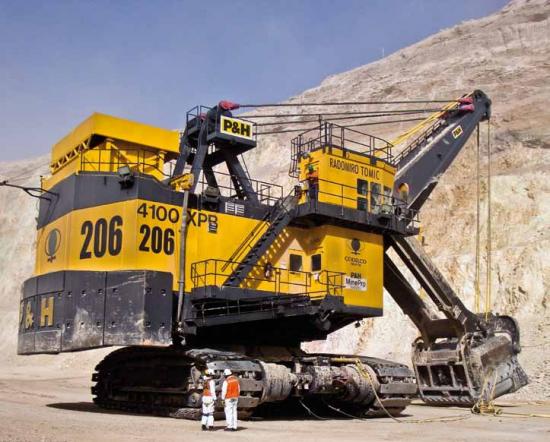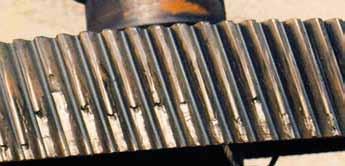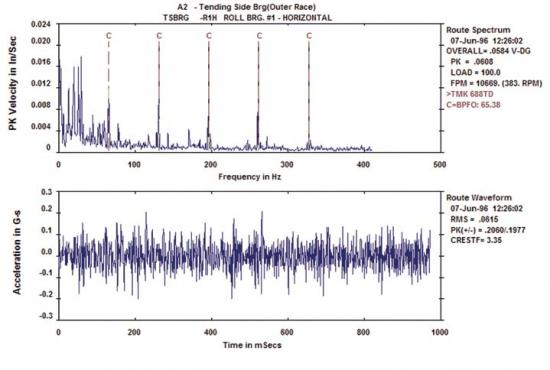Online Vibration Monitoring on Electric Mining Shovels
Electric rope shovels with capacities up to 100 tons (90.8 tonnes) and draglines with bucket capacities up to 160 cubic yards (122 cubic meters) are used for high production loading in surface mines. Due to the global demands for metals and power, mines are required to operate at full capacity. Mine operations cannot afford any critical assets to shutdown unexpectedly; downtime for a single shovel can be as much as US$500,000 per hour.
Electric rope shovels are one of the most critical assets in open pit mining. They are very large, complex machines with DC or AC motors, multiple reduction gearboxes (some of them planetary) and multiple large rolling element bearings. This complexity, combined with the tough 24/7 service, results in too much unplanned shovel downtime, which can affect the entire downstream process.
Monitor or Wait for Shutdown?
Some mining equipment manufacturers and mining companies do not monitor the mechanical health of their many shovels, choosing instead to wait for scheduled shutdown periods. One of the world’s largest manufacturers of above-ground mining equipment, P&H Mining, has chosen to monitor the health of their shovels on a regular basis using vibration analysis. For some time this was done using portable monitoring equipment, but recently they have begun to do it automatically.
Why Vibration Monitoring Is Useful
A mining shovel is difficult to monitor because of its mechanical complexity. For this reason vibration analysis tends to be the best technology to determine its health. Vibration sensors can be attached at the bearing locations on the shovel’s complex gearboxes and motors, either for the duration of the test or put in place permanently. Analysis of the signals from the sensors can identify lubrication issues, early bearing defects, early gear defects (Figure 3), alignment issues, structural issues, manufacturing defects and more. With early detection of developing problems, maintenance actions can be planned with minimal production interruptions, and minor issues can be corrected before they become major faults. If the analysis indicates that a major component will soon need replacement, there is enough time to make plans and order the replacement before a failure occurs.
However, an electric rope shovel is not an easy application for vibration analysis. The shovels are variable-speed systems with short cycle times, complex gearing arrangements and high background vibration levels − not to mention that they tend to be located in some of the most remote places on the planet.
Figure 1. Electric rope shovels with capacities up to 100 tons are one of the most critical assets in open pit mines.
Figure 2. A failed gear can be detected through vibration analysis.
First Application of Vibration Monitoring
P&H Mining Equipment was the first shovel manufacturer to successfully apply predictive technologies and services to its electric rope shovels and other mining assets. This involved not only portable vibration analysis, but also infrared examination, lubricating oil analysis and ultrasonic testing.
From these service offerings grew the P&H MinePro service organisation. For the portable vibration analysis, MinePro used technology from Emerson Process Management’s CSI Portable Technologies and Machinery Health Management (MHM) business, including PeakVueR analysis software. This is designed to pick out and identify the high-frequency components of a vibration signal, which provide early indications of developing bearing faults. These include inner and outer race defects, ball defects, lubrication problems and any type of “impacting” fault, where metal is contacting metal. PeakVue also provides early failure warning of those expensive gearbox components.
Vibration sensors are moved from point to point on various parts of the shovel and connected by portable data-gathering equipment; during which the shovel is then operated through a consistent sequence of motions of the swing, hoist and crowd systems. This is done about once a month, and involves taking the shovel out of production for two to four hours while it goes through simulated operation.
Advantages of the Automated Approach
Planned or not, a shutdown is still a shutdown and can cost up to a million US dollars. In addition, sending personnel to monitor the working parts of the shovel − which must be in motion during many parts of the data acquisition − raises safety concerns; for example, a common test procedure involves making the shovel rotate in a circle like a huge top for 20 minutes with two extra people on board to do the monitoring.
On top of this, simply planning for that monthly outage can be a herculean task, requiring coordination among the production people, the maintenance people, the on-site safety manager and specialised personnel where needed. It is not unusual to have to wait two weeks to get a shutdown scheduled.
If a vibration monitoring system could be permanently mounted to the shovel and operate automatically it could gather information as the shovel is operating, with no shutdown. And it would not need to be scheduled in advance or coordinated with the production department.
Figure 3. Vibration measurements on a shaft with rolling-element bearings. The top chart, in the frequency domain shows vibration peaks at the harmonics of the frequency at which the rolling elements pass any particular spot on the bearing’s outer race. These indicate that there is a defect on the outer race of the bearing, and it will soon fail.
Checking Out Online Monitoring
P&H MinePro decided to evaluate automated, online vibration monitoring. They selected Emerson to put a vibration monitoring system on one of their 4100XPC shovels used at Chilean Copper Corporation (Codelco)’s Radomiro Tomic copper and molybdenum mine, located at an elevation of about 10,000 feet in the Atacama desert in northern Chile. This involved a CSI 6500 Machinery Health Monitor that would continuously monitor the health of the shovel’s swing and hoist systems. Depending on user preference and the availability of resources, the data can be analysed on site or sent via satellite to P&H headquarters.
Acceptance of the automated system was contingent on the data it produced matching that obtained with the portable system. The first trial showed this to be the case.
How Online Monitoring Is Done
The online vibration monitoring systems on P&H’s CenturionR controlled shovels is integrated to the shovel’s PreVailR Remote Monitoring System to send vibration information directly to P&H headquarters. A shovel will generally have one or two CSI 6500 systems, one handling 24 channels and the other 48 channels, to monitor hoist, crowd and swing systems; a dragline may have as many as eight.
Emerson’s AMS Machinery Manager is also installed on-board the shovel. Accelerometers (the sensor of choice) are mounted to bearing locations on the shovel. Data is collected under the same conditions for both trending and analysis.
PeakVue is a measurement technique that detects and analyses stress waves using peak value analysis. It allows for early detection of bearing and gear defects by filtering out background and non-repetitive vibration to produce repeatable and trendable data. Documenting failure progression for bearing and gear problems and comparing them with recommended alarm levels makes it possible to determine the stage of failure and severity.
The vibration levels in gearboxes and motors vary with speed and direction, so in order to get meaningful data it is necessary to measure only when the shovel is making particular movements at particular speeds. For the CSI 6500 this is simply a matter of setting the equipment to watch for those conditions to occur and only then take data. This may mean that, out of perhaps 300 cycles that a shovel completes in one eighthour shift, only three will meet the criteria for gathering data, but that is more than enough − especially compared to the previous once-a-month regime.
Staged Testing
There is also a stage test done once per shift, the operator will activate a switch to initiate the test with the shovel’s PreVail control system which then operates the swing, crowd and hoist systems in a pre-set pattern long enough for a test. This is generally done during idle time (while waiting for a truck, for example), so it takes no production time. When data collection is complete the system informs the operator.
On the first automatic vibration monitoring installation the system was able to trigger and collect data both during staged test and during digging operations. Repeatable data was collected at 1000 Hz/3200 LOR (lines of resolution) each cycle during dipper latching. The data was found to be repeatable.
Payback and Future Plans
Results have been good. Data is now collected more often than daily, with no outage needed, which means there is no lost revenue just to acquire vibration data (instead, the scheduled outage can be used for true repairs).
The installed cost of a CSI 6500-based monitoring system for a typical mining shovel is on the order of US$200,000 to US$250,000, which is recovered when the first hour of unplanned downtime is prevented. Of course this depends on the material (ore and ore quality) being mined.
Plans call for the vibration monitoring equipment to download its data wirelessly to a pickup truck parked nearby, which will then take the data back to the shop for analysis. And that same thing can happen via PreVail shipping the information back via satellite. Wireless communication systems continue to improve in the mining pit and will soon remove the pickup truck from the process, sending the data directly to the maintenance engineer’s desk. No user has yet reached the point that it will allow the vibration analysis to automatically trigger a repair order, insisting that an analyst review it first.
While artificial intelligence is progressing, nobody is yet ready to allow the equipment to make a decision that will involve shutting a machine down without having a human in the loop.













